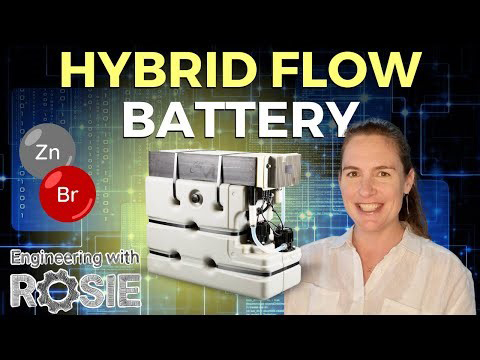|
20 June 2023
By
Engineering
With Rosie
Are Flow Batteries About to Take Over? A Lab
Tour of RedFlow's Zinc Bromine Battery
Join me on this project tour of Redflow's
hybrid flow battery facility in Brisbane, Australia. Energy storage
is a huge topic these days as electricity grids are seeing larger
and larger proportions coming from variable renewable sources like
wind and solar and storage is used to fill the gaps between variable
supply and demand.

Click above to view
the video
Energy storage is a huge topic these days as
electricity grids are seeing larger and larger proportions coming
from variable renewable sources like wind and solar and storage is
used to fill the gaps between variable supply and demand.
Traditionally, nearly all storage in the electricity grid came
through hydroelectric dams, but in recent years the new storage
capacity that’s been added has been overwhelmingly lithium-ion
batteries. This has occurred in tandem with EVs and their lithium
ion batteries also experiencing exponential growth. But if this
exponential trend is going to continue, there will be supply chain
problems to overcome as there aren’t yet enough mines for several
key minerals, like lithium, to fill all the projected demand over
coming decades. This is one of the number one objections that I hear
from climate pessimists: we don’t have enough critical minerals to
make enough lithium ion batteries to support a 100% renewable
electricity grid. Now, those arguments are misleading for several
reasons, but the main one is that lithium ion batteries aren’t the
only electricity storage technology available.
Lithium ion batteries are incredibly appealing for EV applications
because they can pack a lot of energy into a small and light
package. But for stationary storage, the size and weight don’t
really matter. What does matter is cost, especially for longer
storage durations of ten hours and more. That’s something that li-ion
batteries don’t do particularly well. To double the storage duration
of a lithium ion battery you pretty much need to double the cost.
That is not the case for flow batteries, which is the topic of
today’s video.
Flow batteries are a type of rechargeable battery that use two
chemical components dissolved in liquid electrolyte. The electrolyte
is stored in external tanks and pumped through a reaction chamber to
produce electricity. The key thing about flow batteries is that is
cheap to increase the storage duration, much cheaper than for
lithium ion batteries – I’ll explain why later on.
Last year while I was in Brisbane I had a chance to tour a hybrid
flow battery manufacturer, Redflow.
In this video we’re going to look at how their batteries work, how
they’re tested and how their design has evolved over the years.
I was keen to visit Redflow because while the hype around flow
batteries is a pretty recent thing, these guys are no spring
chickens. They kicked off pilot studies back in 2010 and by now
there are Redflow batteries in over 250 sites. Originally they were
just selling single 10kWh batteries for residential and remote
sites, for example for communications. And these days they are
looking at large modular systems in the tens to hundreds of MWh.
Bookmarks
00:00 Intro
00:50 Redflow
01:12 How does a hybrid flow battery work?
02:10 Anatomy of a Redflow Battery
03:49 Pure vs Hybrid Flow Batteries
04:48 Redflow’s Technology Development
06:26 Recyclability of Redflow’s Batteries
07:15 Applications and Scale Up Plans
09:19 Latest updates from Redflow
09:47 Outro
The Engineering with Rosie team is:
Rosemary Barnes: presenter, producer, writer
Kevin Irman: research, calculations, assistant editor
Javi Diez: editor https://www.linkedin.com/in/javierdie...
Traditionally ...
Green Play Ammonia™, Yielder® NFuel Energy.
Spokane, Washington. 99212
509 995 1879 Cell,
Pacific Time Zone.
General office: 509-254
6854
4501 East Trent Ave.
Spokane, WA 99212
|